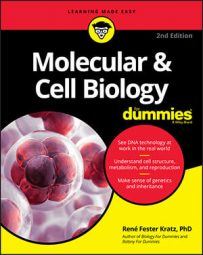- Metabolic changes are broken down into small steps, each of which is a single chemical reaction. Several reactions in a series make up a metabolic pathway.
- Enzymes are very important to a functioning metabolism. They speed up chemical reactions by lowering the energy of activation so that metabolism occurs quickly enough to support life.
- Electrons are transferred from one molecule to another during many metabolic reactions. Molecules that lose electrons are oxidized; those that gain them are reduced. Electron carriers, such as nicotinamide adenine dinucleotide (NADH), shuttle electrons between reactions.
- Energy is transferred during metabolic reactions. The energy carrier ATP transfers energy to or from reactions.
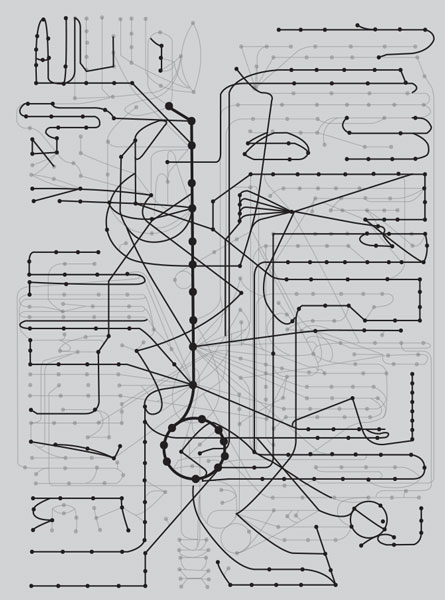 A metabolic map showing the molecules (dots) and chemical reactions (lines) that make up the metabolism of a cell.
A metabolic map showing the molecules (dots) and chemical reactions (lines) that make up the metabolism of a cell.Taking baby steps during chemical reactions
In cells, chemical reactions usually happen in many small steps rather than one quick change. By doing many small reactions, cells control the energy changes and prevent cellular damage. For example, a cell that needs to make molecule F out of molecule A might do so in five small steps:A→ B→ C→ D→ E→ FA represents the starting molecule, or substrate. F represents the ending molecule, or product. B, C, D, and E all represent molecules that were made during the conversion of A to F; they’re called intermediates. Every arrow represents one step, or reaction, as a chemical change occurred.
Metabolic pathways connect with each other forming a complex interlocking web. The connections and complexities in metabolism occur when:
- The product of one pathway is the substrate of another.
- A pathway may have one or more branches as intermediates connect with other pathways.
- Some metabolic pathways are circular, re-creating the initial substrate during the pathway so that it can repeat, as shown. These types of pathways are called metabolic cycles.
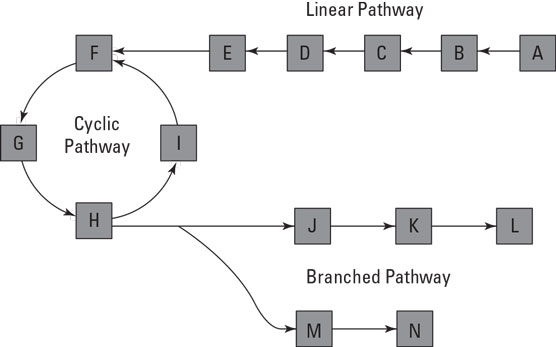 Metabolic pathways.
Metabolic pathways.Helping hands from enzymes
Life is very fast paced — too fast to just wait around for necessary chemical reactions to occur, even spontaneous reactions. Although spontaneous reactions are energetically favorable and can occur without energy input from the cell, there is no guarantee on exactly when they will occur. In order for a spontaneous reaction to happen, the reactants must find each other and then collide in just the right way and with enough kinetic energy to trigger the necessary changes for the reactants to convert into products. As the reactants interact, they form a temporary intermediate called the transition state intermediate. So, spontaneous reactions are just waiting to happen, but they need a little energy from the collision of the reactants to get to the transition state.The amount of energy necessary to trigger a reaction is called the energy of activation (Ea). Without help from enzymes, spontaneous reactions wouldn’t happen quickly enough to support life. For example, you probably know that if you eat sugar, your body will break it down in order to get some usable energy from the sugar. The breakdown of sugar is a spontaneous, exergonic reaction that releases usable energy to cells. However, if you were to place a bowl of sugar on your kitchen table and stare at it, it’s highly unlikely that the sugar would begin to disappear before your very eyes. Outside of your cells, the sugar molecules don’t have enough kinetic energy to overcome the barrier (see the following figure).
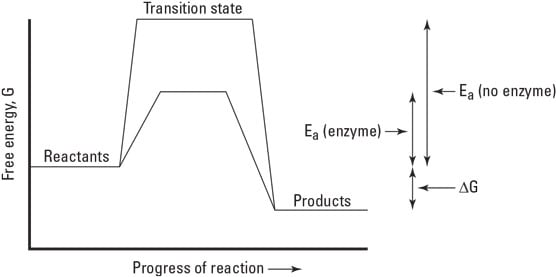 Energy of activation with and without enzymes.
Energy of activation with and without enzymes.Cellular enzymes make a huge difference between the breakdown of sugar inside your cells and outside of your cells. Enzymes are important to cells because
- Enzymes lower the energy of activation for reactions, making it easier for collisions between reactants to provide enough activation energy (compare the Ea for the reaction in the figure with and without enzymes).
- Every reaction that occurs in cells is catalyzed by an enzyme. Because enzymes are very specific and can bind to only a certain substrate, each reaction requires a unique enzyme.
A→ B→ C→ D→ E→ FEach reaction in this pathway would be catalyzed by a different enzyme, requiring a total of five enzymes to complete the pathway. If you refer to Figure 10-1 and look at all the reactions drawn on the metabolic map, you can get an idea of the hundreds of enzymes that may be needed at any one time in a cell.
Enzymes lower the activation energy of reactions, making it easier for reactants to have productive collisions. Productive collisions are those that have enough energy to overcome the energy of activation.
In order for productive collisions to occur:- The particular reactants for a reaction must collide with each other.
- The reactants must be oriented toward each other in the right way so that the correct chemical groups come into contact.
- The reactants must have enough kinetic energy to overcome the energy of activation.
- Enzymes bind reactants (substrates) in their active sites, bringing the necessary reactants for a reaction together in the proper orientation for the reaction to occur.
- The functional groups on the amino acids that make up the enzyme interact with the reactants, altering chemical bonds so that the changes necessary to reach the transition state are more likely to happen.
Giving and taking electrons in redox reactions
During metabolic reactions, electrons are often transferred from one molecule to another.Molecules change when they give or take electrons (as shown):
- When a molecule gives up an electron, it’s oxidized.
- When a molecule accepts an electron, it’s reduced.
Sodium is oxidized and becomes the sodium ion (Na+). Chlorine is reduced and becomes the chloride ion (Cl). Because oxidation and reduction reactions occur together — one molecule is oxidized, and one is reduced — these reactions are called redox reactions.
It seems backwards to think that when a molecule gains an electron, it’s reduced. Reduced means less, right, so how can gaining an electron make you reduced? The reason for this contradiction is because elements are compared to their most oxidized state. So, if you think of most oxidized as the max, then every electron a molecule accepts moves it away from the max, or reduces it. Too confusing? Then just remember this friendly little sentence, “LEO the lion goes GER.” This stands for Loss of Electrons is Oxidation (LEO); Gain of Electrons is Reduction (GER). This shortcut never fails.
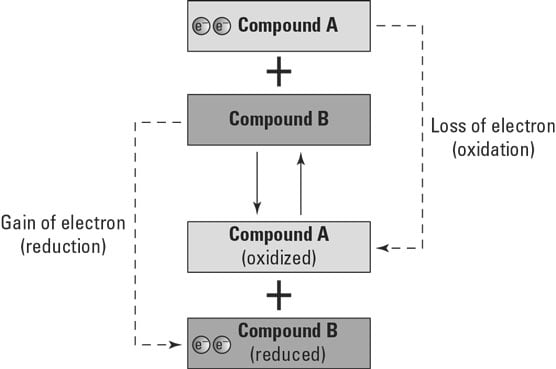 Redox reactions.
Redox reactions.Shuttling electrons with electron carriers
Sometimes electrons are moved directly from one molecule to another during metabolism. Frequently, however, cells use an intermediate molecule, called an electron carrier. Electron carriers act like electron shuttle busses, accepting electrons from one reaction and then transferring those electrons to another reaction. During metabolism, these electrons are often moved as part of hydrogen atoms (H) that are stripped from one molecule and then given to another.Electron carriers cycle between two forms, an oxidized form and a reduced form, as they shuttle electrons (or hydrogen atoms) around the cell.
- The oxidized form of a carrier accepts electrons from reactions. When it accepts electrons, it becomes reduced.
- The reduced form of a carrier donates electrons to reactions. When it donates electrons, it becomes oxidize
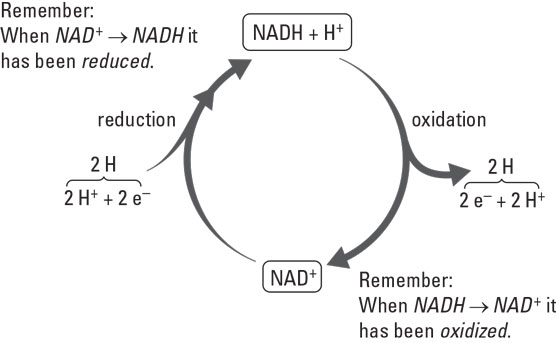 The electron carrier NAD+/NADH + H+.
The electron carrier NAD+/NADH + H+.Nicotinamide adenine dinucleotide (NAD+/NADH), shown in the following figure, is a good example of an electron carrier. It’s made of two nucleotides hooked together. The nitrogenous base of the upper nucleotide is the part of the molecule that accepts and donates electrons.
As NAD+/NADH shuttles electrons, it alternates between two forms:
- When the carrier is in its oxidized form, the nitrogenous ring carries a positive charge. This form of the carrier is NAD+.
- The carrier is reduced when it accepts one electron, which neutralizes the charge, plus one entire hydrogen atom. The reduced form of the carrier is NADH + H+.
Whenever NAD+ accepts electrons, it’s converted to NADH + H+. The +H+ seems like a little brother always following the NADH around. During metabolism, electrons are often stripped off molecules as part of hydrogen atoms. Each hydrogen atom consists of one proton and one electron. When two hydrogen atoms are removed from a molecule during redox reactions, NAD+ can carry one electron, plus one whole hydrogen atom, in its nitrogenous ring. However, it can’t accept one proton. This proton is released into the cell, which is shown by writing +H+, which represents a proton, after the NADH.
You can easily remember which form of an electron carrier is the oxidized form and which one is the reduced just by looking at its name. When electron carriers are reduced, they’re carrying their electron passengers in the form of hydrogen atoms. They show that they are carrying passengers by putting the letter H for hydrogen in their name, as in NADH. The oxidized form of the electron carrier doesn’t have the H, as in NAD+, which reveals that it’s not carrying any passengers.
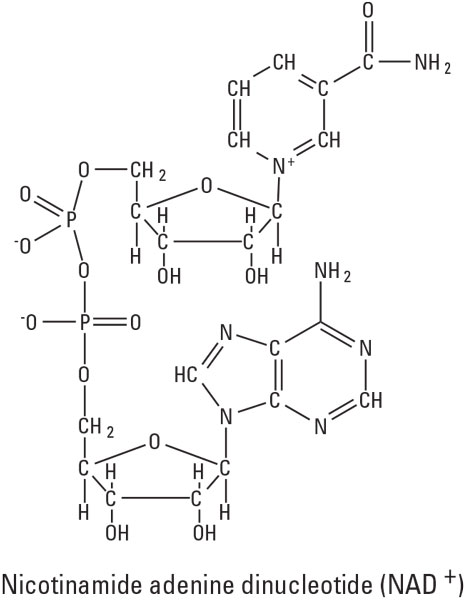 The electron carrier cycle.
The electron carrier cycle.Getting what you need at the cellular level
Metabolism is all about getting what you need to stay alive. You know what you need on the big scale — good old food, clothing, and shelter. But on the small scale, on the cellular level, what you need to keep your cells functioning comes down to a different three things:- Building blocks for growth and repair. Your cells need a constant supply of materials to obtain the building blocks for the molecules that make up the cell. Food molecules are broken down by catabolism, and their building blocks are rearranged to form the molecules of the cell by anabolism.
- Energy for cellular work. Your cells need a constant supply of energy to allow cellular work, such as building molecules, moving things, and organizing cellular components. Food molecules are broken down by catabolism, allowing the transfer of energy from food to the cell.
- Reducing power. Your cells need a constant supply of electrons during anabolism in order to build the molecules that make up the cell. During catabolic reactions, electrons from food are transferred to electron carriers. These electron carriers then provide the needed electrons during anabolism.

